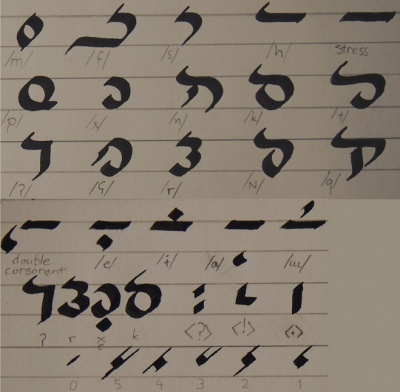User:Juhhmi/Kher: Difference between revisions
mNo edit summary |
mNo edit summary |
||
| Line 3: | Line 3: | ||
The language consisted of quadriliteral roots similar to [[w:Semitic_root|Semitic roots]] modified through transfixation (apophony) to change the root word into a different part of speech. | The language consisted of quadriliteral roots similar to [[w:Semitic_root|Semitic roots]] modified through transfixation (apophony) to change the root word into a different part of speech. | ||
[[File:KherMiddle.JPG|400px|thumb|right| | [[File:KherMiddle.JPG|400px|thumb|right|Writing system of Middle Kher.]] | ||
The Kher script was an abjad, which only marks the consonants. This main feature has survived into the modern scripts as well. Despite sound changes, such as assimilation, the words in modern languages are still written with original four graphemes, because transfixes may bring back some sounds otherwise unvoiced. | The Kher script was an abjad, which only marks the consonants. This main feature has survived into the modern scripts as well. Despite sound changes, such as assimilation, the words in modern languages are still written with original four graphemes, because transfixes may bring back some sounds otherwise unvoiced. Stress grapheme is used for example to write initials (with a shorter stroke), to complete words into quadriliterals and to change pronunciation (lost sounds of ancient Kher) | ||
==Sound changes== | |||
Sound changes from Ancient Kher: | Sound changes from Ancient Kher: | ||
| Line 37: | Line 39: | ||
|- | |- | ||
!/k/ | !/k/ | ||
| | | kʰ? || || || || || || | ||
|- | |- | ||
!/ʜ/ | !/ʜ/ | ||
| Line 58: | Line 60: | ||
|- | |- | ||
!/p/ | !/p/ | ||
| | | pʰ? || || || || || || | ||
|- | |- | ||
!/d/ | !/d/ | ||
| Line 79: | Line 81: | ||
|- | |- | ||
!/t/ | !/t/ | ||
| | | tʰ? || || || || || || | ||
|- | |- | ||
!/ɢ/ | !/ɢ/ | ||
| Line 94: | Line 96: | ||
|- | |- | ||
!/r/ | !/r/ | ||
| r || r || r || ɾ || ʀ || ʁ || ʁ<br>ʀ/_∅>ɐ | | r || r || r || ɾ || ʀ || ʁ || ʁ<br/>ʀ/_∅>ɐ | ||
|- | |- | ||
!/ʕ/ | !/ʕ/ | ||
| Line 103: | Line 105: | ||
|- | |- | ||
!/q/ | !/q/ | ||
| q || q || q || q || q<br>q/_∅>k || q || k | | q || q || q || q || q<br/>q/_∅>k || q || k | ||
|- | |- | ||
!/kəx/ | !/kəx/ | ||
| Line 112: | Line 114: | ||
|} | |} | ||
==Orthography== | |||
*Assimilation | *Assimilation | ||
*Middle Kher nasals + stress grapheme as matres lectionis | *Middle Kher nasals (+ stress grapheme) as matres lectionis | ||
**m: ewe>u; n: ele>a; ... | |||
Latest revision as of 23:04, 31 January 2015
Kher /χəɾ/ languages descend from the Ancient Kher (kexére7 /kəxerəʔ/) spoken about 2600 years ago in south-western Frostroot, in the coastal region nowadays under the control of Khat Empire. During the great split, the language evolved into two main branches: western on islands of Qekha, Guard and Border Chain, and eastern on north-western coast of Cold Sea. Eastern branch includes the eastern and southern descendants which vary more in sound but less in grammar.
The language consisted of quadriliteral roots similar to Semitic roots modified through transfixation (apophony) to change the root word into a different part of speech.
The Kher script was an abjad, which only marks the consonants. This main feature has survived into the modern scripts as well. Despite sound changes, such as assimilation, the words in modern languages are still written with original four graphemes, because transfixes may bring back some sounds otherwise unvoiced. Stress grapheme is used for example to write initials (with a shorter stroke), to complete words into quadriliterals and to change pronunciation (lost sounds of ancient Kher)
Sound changes
Sound changes from Ancient Kher:
- Devoicing of consonants
- Epiglottals into glottals
Sound changes from Middle Kher:
- /kəˈxeˌrəʔ/>/kxe.rə/>/kxer/>
- >/kʰər/>/χəɾ/ in west
- >/ʔxeʀ/
>/xɛʁ/ in east
>/xəɐ/ in south
- /qe.kəˈxa.ʔə/>/qekxʌ:/>
- >/qəˈχʌ/ in west
- >/qeʔˈxʌ:/
>/qəˈxɔ/ in east
>/kɛˈxɑ/ in south
- /təʕeqepə/>/tˤeqep/>
- >/tˤəqəpʰ/ in west
- >/tˤəqɛp/ in east (e>ɛ before a labial)
>/tˤəkɛp/ in south
| Ancient | Middle | Changing | Western | West | Eastern | East | South |
|---|---|---|---|---|---|---|---|
| /h/ | long vowel | ||||||
| /k/ | kʰ? | ||||||
| /ʜ/ | h | ||||||
| /s/ | s | ||||||
| /j/ | j/ə_ə>ɨ: | ||||||
| /v/ | f | ||||||
| /m/ | m? | ||||||
| /w/ | w/ə_ə>ɯ: | ||||||
| /p/ | pʰ? | ||||||
| /d/ | t | ||||||
| /g/ | k | ||||||
| /n/ | n? | ||||||
| /l/ | l/ə_ə>ä: | ||||||
| /x/ | x | ||||||
| /b/ | p | ||||||
| /t/ | tʰ? | ||||||
| /ɢ/ | q | ||||||
| /ɴ/ | ɴ? | ||||||
| /ŋ/ | ŋ? | ||||||
| /ɰ/ | x | ||||||
| /r/ | r | r | r | ɾ | ʀ | ʁ | ʁ ʀ/_∅>ɐ |
| /ʕ/ | ʕ | ||||||
| /ʡ/ | ʔ | ||||||
| /q/ | q | q | q | q | q q/_∅>k |
q | k |
| /kəx/ | kəx | kx | kʰ | χ | ʔx | x | x |
| ... (vowels) |
Orthography
- Assimilation
- Middle Kher nasals (+ stress grapheme) as matres lectionis
- m: ewe>u; n: ele>a; ...
